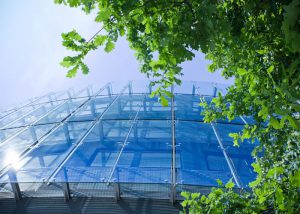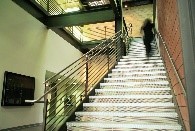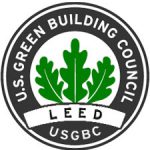Green Building Design
Overview
According to the U.S. Environmental Protection Agency (EPA), green building design “is the practice of creating structures and using processes that are environmentally responsible and resource-efficient throughout a building’s life-cycle from siting to design, construction, operation, maintenance, renovation and deconstruction.” The EPA estimates that buildings (non-residential structures) account for 39% of total energy use, 12% of total water consumption, 68% of total electricity consumption, and 38% of carbon dioxide emissions in the U.S. This means that there are many opportunities to green healthcare buildings and realize environmental, economic, and social benefits.
Environmental benefits of green building design include:
- Decreased use of natural resources through the use of recycled and sustainable building materials
- Decreased energy usage, particularly for heating and cooling
- Reduced water usage by facility processes and occupants
Green buildings may also take advantage of renewable energy sources or water reuse systems, and they may encourage occupants to participate in environmental programs, such as a robust recycling system, environmentally preferred purchasing, and the use of more daylight or highly efficient LED lighting. These types of features result in a building with a smaller environmental impact.
Economic benefits of green building design result from savings in operating budgets. Green buildings generally use fewer resources (electricity, natural gas, water, etc.), so utility bills are not as high as they would be in a conventionally designed space. Depending in part on the type of building being constructed, green buildings may or may not cost more than traditional buildings up-front to design and build. Given the variety of green building options available, there are affordable and appropriate options for any building project.
Social benefits result from features such as healthier finishes, like low-VOC paint, and the use of natural daylight. Studies have shown that building occupants prefer working in green buildings over conventional buildings. Green buildings may also take advantage of mass transportation or spaces for electric vehicle parking, bike racks or bike share systems, and other design features that allow occupants to reduce their own environmental footprints. With regard to healthcare specifically, studies show that green healthcare buildings are more conducive to healing. A comprehensive article on the benefits of a healing environment as it relates to green building design, Creating Optimal Healing Environments in a Healthcare Setting, was published in Minnesota Medicine’s 2008 issue.
U.S. Green Building Council (USGBC) and LEED
The U.S. Green Building Council (USGBC) is a well-known third party rating organization for green buildings. Their designation, Leadership in Energy & Environmental Design (LEED), provides a checklist for the building design or upgrade process, and a facility earns credits for the implementation of aspects deemed green. There are five categories of LEED certification: Building Design and Construction, Interior Design and Construction, Building Operations and Maintenance, Neighborhood Development, and Homes.
Hospitals that operate constantly and that have inpatient medical treatment should consider the Building Design and Construction standard that applies to healthcare specifically. Other healthcare facilities can take advantage of any of the categories that apply to their type of upgrade or design. There is a cost to participating in the LEED process, but the benefit is that your building becomes LEED-certified with a designation of certified, silver, gold, or platinum. You may have seen LEED certification plaques on the front of some buildings. This designation tells your patients and customers that they are visiting a green facility.
LEED credits are given based on a number of design features, including:
- Access to quality transit
- Reduced parking footprint
- Site development (protect or restore habitat)
- Rainwater management
- Heat island reduction

- Light pollution reduction
- Indoor water use reduction
- Enhanced commissioning (HVAC and building systems)
- Optimized energy performance
- Green power and carbon offsets
- Construction and demolition waste management planning
- Sourcing of raw materials
- Indoor air quality performance
- Low-emitting building materials and finishes
- Daylight and interior lighting
- An emphasis on innovation
For more information, visit USGBC’s main website or the Minnesota chapter’s website.
Green Guide for Healthcare (GGHG)
Another tool available for healthcare facilities is the Green Guide for Healthcare (GGHC), developed jointly by Health Care Without Harm and the Center for Maximum Potential Building Systems. The GGHC is a free technical guide to building or upgrading healthcare facilities to green standards. For more information and to download a free copy of the guide, visit www.gghc.org.
Other Resources and Links
- The U.S. Environmental Protection Agency maintains a webpage on Green Building Standards.
- The Minnesota Pollution Control Agency (MPCA) maintains a Green Building webpage and teams with other agencies and groups to help advance sustainable building practices in Minnesota.
- Practice Greenhealth maintains information on Green Design and Construction and has both current and archived healthcare-specific webinars on this topic.
